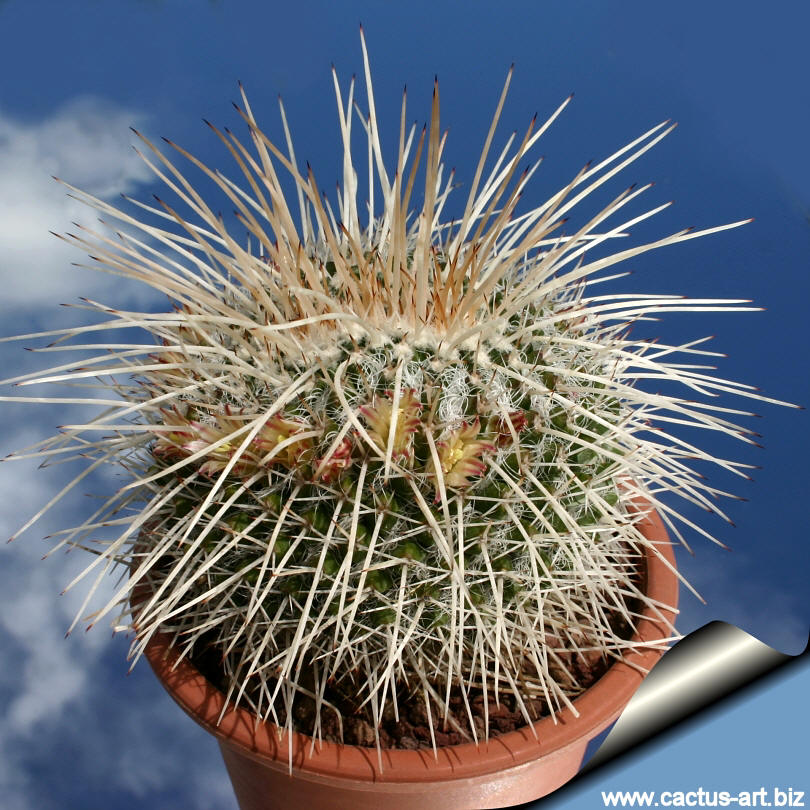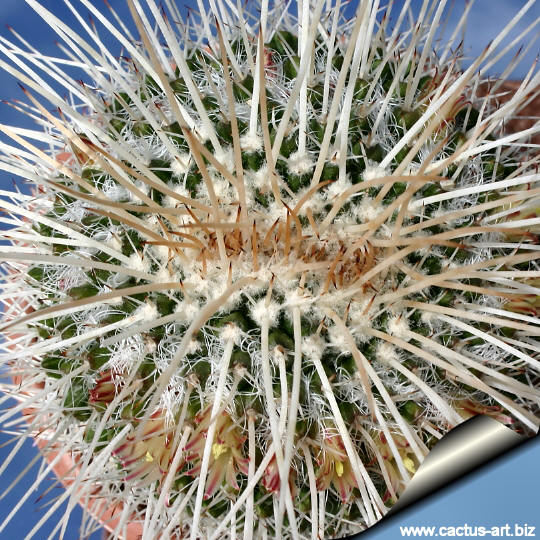|
|
|

Mammillaria karwinskiana
ssp. nejapensis (var. longispina)
This
species forms globular stems with silvery white spines up to 5 cm in
length, and dense wool and bristles at the areoles. Each single stem
begins to divide dichotomously to form two stems, and will slowly form
large clusters. Some consider this synonymous with
M.
karwinskiana.
|
|
Description:
Mammillaria nejapensis is very variable, especially for the length of the
spines, and at the beginning there
were two recognized varieties: var. brevispina and var.
longispina, with respectively
short and long spines, but they are merely local or individual
variations. This species branches basally or more frequently forms large
colonies by dichotomous division.
Stem: Globose to short cylindrical, somewhat wider in the upper
part, blue-green to dark green, to 15 cm high and 5 - 7.5 in diameter,
with
latex. A cream coloured 'snowy'
tomentum is present on the top of the plant.
Tubercle: Tubercles firm, pyramidal with the lacteal juice,
arranged spirally with 13-21
parastichys
Axil: With much wool and many tortuous bristles.
Radial spine: Only 3 - 5, awl-like, straight to slightly curved,
ivory with reddish-brown tips, becoming chalky white with age, the upper
shorter, 2 - 5 mm long, the lowermost the longest, to 25 or even 50 mm
(or more) long.
Central spine: Absent.
Flower: Diurnal, funnel-form, 18 mm long, 10 mm in diameter, pale
cream with red-brown to scarlet midstripe on each petal.
Blooms adorn the crown of the plant, usually in a ring, in the growth of
the previous year.
Blooming seson: Spring to summer.
Fruit: Bright or clear red elongated and quite
attractive.
Seed: Brown. |
|
M. karwinskiana is a very variable
species, and some of the different growing forms has
been for a long time considered
a separate and
distinguished variety, for example:
-
ssp.
karwinskiana has medium yellow flowers with purpleish
mid-veins,
no central spine, and 6 radial spines.
- ssp. collinsii has white flowers
with deeper pinkish mid-veins,
one central spine, and 7 radial spines.
- ssp. beiselii has white flowers
with red tinted mid-veins,
one central spine, and 5-8 radial spines.
-
ssp. nejapensis
also has white flowers with red tinted midv-eins, but the spines are
larger and white and have much more wool.
No central spines, and 3-5
radial spines per areole.
Cultivation: It is easy to
cultivate and make interesting specimens for any collection, and over
time (in 12-15 years) it will form enormous colonies up to 50 cm
or more in diameter! It
grows by dichotomously dividing, and also by
producing offsets, and doesn't
require any special treatment, except
for the need for frequent transplanting, in order
to manage its exuberance. It needs as much light as
possible without burning the plant, to keep the stems compact.
Provide a well-drained soil mix. Water well and then allow to dry
thoroughly before watering again during the growing season.
It doesn't like
much, if any, winter water, but can survive short exposures to freezing
temperatures (-4° C.) if properly hardened off and kept dry.
Propagation: Mammillaria nejapensis is best propagated
from seed. Seed readily germinates at 20°-22°C, or by offsets if
available. |
|
Advertising
|
|
|
|
|
|
Family:
Cactaceae
(Cactus
Family)
Scientific name:
Mammillaria karwinskiana subsp. nejapensis (R. T. Craig) D. R.
Hunt 1997
First description: Mammillaria nejapensis R. T. Craig &
Dawson
in: Allan Hancock Found. Occ. Pap. 2: 57 (1948)
Origin: From Oaxaca city, towards Totalapan, in the
NW area around Nejapa. (Rio Totolapan, San Pedro Totalapan-Mitla,
Teotitlan, Las Animas, E of Miahuatlan, Los Cantiles, El Camaron-Mitla,
San Cristobal, San Luis Amatalan- San Jose Lachiguri, Oaxaca-Tehuantepec)
Altitude 850 - 1.650 m.
Conservation status: Listed in
CITES appendix 2.
Synonyms:
- Mammillaria karwinskiana
First description by Martius, Nov. Act. Nat. Cur.
16(1): 335 (1832)a
- Mammillaria nejapensis var. brevispina
- Mammillaria nejapensis var. longispina
Common Names include: "Owl
Eyes" and "Royal Cross"
|
|
|
|

This is one of the Mammillaria commonly called
"Owl Eye Cactus", known for
dichotomous branching (forking or dividing into two parts). Although
dichotomous branching is not a common occurrence in cacti in general, it
happens for some reason in this particular subspecies. What is
interesting about this cactus is that it began as a single head, and it
has now divided twice, forming what will be four separate branches. When
the division process started, it was obvious that four heads would
appear, but I don’t think the one head divided quadruply. Most probably,
one head became two, and then those two immediately divided.
Other Owl Eye Cactus among others comprise:
M.
karwnskiana,
M. tlalocii and
M. perbella.


|
|